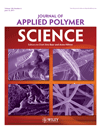Drug release behaviors of a novel pH/temperature-responsive chitosan-poly(N-acryloylglycinate) hydrogel
Abstract
A pH/temperature and degradable-responsive hydrogel (PSMEA) was prepared from chitosan (CS), N-acryloylglycine methyl ester (NAGME), N-acryloylglycine ethyl ester (NAGEE), acrylic acid (AA), and N-methylenebisacrylamide (NMBA). The swelling properties of PSMEA were systematically investigated at different temperatures, pH, and CS contents. It was found that the PSMEA demonstrated obvious pH and temperature-responsive natures. The caffeine-release behaviors showed that only 42.9% caffeine was released from PSEMA in pH 2.1 phosphate buffer solution (PBS) after 360 min, whereas more than 71.5% caffeine was gradually diffused into pH 7.4 PBS over the same time interval. In addition, the caffeine release was much higher at 37.0°C than that at 14.0°C in PBS medium. The apparent degradability of PSMEA was also observed in the pH 7.4 PBS at 37.0°C through the chemical cleavage of CS. As seen from the results, PSEMA seems to be a potential application in the drug-delivery system controlled by the external pH value and temperature. © 2011 Wiley Periodicals, Inc. J Appl Polym Sci, 2011




